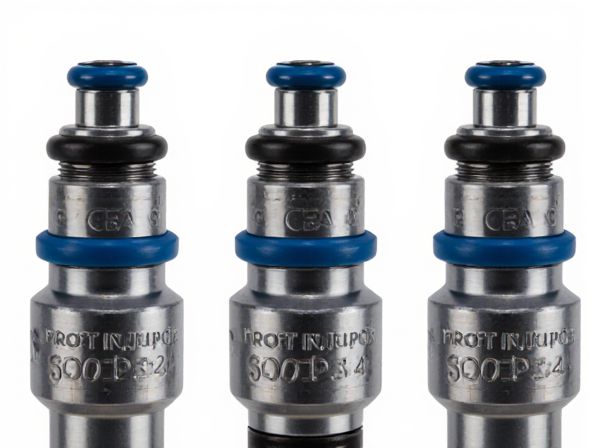
Photo illustration: Port Injector vs Direct Injector
Port injectors deliver fuel into the intake manifold, allowing better fuel atomization and improved air-fuel mixing before entering the combustion chamber. Direct injectors spray fuel directly into the combustion chamber, offering precise fuel delivery and increased power efficiency but can cause carbon buildup on intake valves. Your choice depends on the balance between performance, fuel efficiency, and maintenance preferences.
Table of Comparison
| Feature | Port Injector | Direct Injector |
|---|---|---|
| Injection Location | Intake manifold port | Directly into combustion chamber |
| Fuel Efficiency | Moderate | Higher, precise fuel delivery |
| Emissions | Higher HC emissions | Lower HC emissions, better combustion |
| Power Output | Standard | Improved, more power |
| Complexity | Simple, easy maintenance | More complex, higher cost |
| Fuel Atomization | Less precise | Highly precise |
| Common Usage | Older vehicles, carburetor replacement | Newer vehicles, performance engines |
Introduction to Fuel Injection Systems
Port injectors deliver fuel into the intake manifold ahead of the intake valves, allowing for better fuel-air mixing and reduced carbon buildup on valves. Direct injectors spray fuel directly into the combustion chamber, providing precise fuel delivery and improved combustion efficiency, essential for modern high-performance and high-efficiency engines. Both systems are integral to fuel injection technology, enhancing engine performance, emissions control, and fuel economy in internal combustion engines.
What is a Port Injector?
A port injector is a fuel injection system where fuel is sprayed directly into the intake manifold, positioned just before the intake valve, allowing for better air-fuel mixing and improved combustion efficiency. Unlike direct injectors that deliver fuel directly into the combustion chamber, port injectors operate at lower pressures, reducing carbon buildup on valves and enhancing engine longevity. This system is commonly used in older or less performance-focused engines due to its relatively simpler design and cost-effectiveness.
What is a Direct Injector?
A direct injector delivers fuel directly into the combustion chamber, resulting in precise fuel atomization and improved combustion efficiency. This method enhances power output and reduces emissions compared to port injectors, which spray fuel into the intake manifold. Direct injection technology is commonly used in modern gasoline and diesel engines to optimize performance and fuel economy.
Key Differences Between Port and Direct Injection
Port injectors spray fuel into the intake manifold, allowing it to mix with air before entering the combustion chamber, while direct injectors deliver fuel directly into the combustion chamber for more precise control. Port injection typically results in better fuel atomization and reduced carbon buildup on intake valves, whereas direct injection improves power output and fuel efficiency by enabling higher compression ratios. The choice between port and direct injection impacts engine performance, emissions, and maintenance requirements.
Performance Comparison: Port vs Direct Injectors
Port injectors deliver fuel into the intake manifold, promoting better atomization and mixing with air, which enhances throttle response and reduces carbon buildup on intake valves. Direct injectors spray fuel directly into the combustion chamber, increasing combustion efficiency, improving power output, and reducing emissions, especially under high-load conditions. Performance-wise, direct injectors offer higher pressure fuel delivery and precise control, resulting in better fuel economy and increased horsepower compared to port injectors.
Emissions and Fuel Efficiency
Port injectors deliver fuel into the intake manifold, promoting better air-fuel mixture and generally reducing particulate emissions, resulting in cleaner combustion compared to direct injectors. Direct injectors spray fuel directly into the combustion chamber, enhancing fuel atomization and combustion efficiency, which can improve fuel economy and power output but may increase particulate and NOx emissions due to higher combustion temperatures. Combining both systems in a dual-injection setup can optimize emissions control and fuel efficiency by balancing thorough mixing and precise fuel delivery.
Maintenance and Reliability
Port injectors offer easier maintenance due to their accessible location in the intake manifold, allowing for simpler cleaning and replacement compared to direct injectors. Direct injectors, positioned inside the combustion chamber, provide better fuel atomization and efficiency but are more prone to clogging and require specialized service tools for maintenance. Reliability of port injectors benefits from less exposure to combustion chamber conditions, whereas direct injectors face higher thermal and deposit-related stress, potentially leading to more frequent failures.
Cost Considerations
Port injectors generally cost less to manufacture and maintain due to their simpler design and easier accessibility compared to direct injectors, making them a budget-friendly choice for many standard vehicles. Direct injectors, although more expensive initially and costly to repair or replace, offer improved fuel efficiency and performance, which can lead to long-term savings on fuel expenses. Vehicle owners must weigh upfront installation and repair costs against potential fuel economy benefits when choosing between port and direct fuel injection systems.
Applications in Modern Vehicles
Port injectors and direct injectors are both critical fueling technologies in modern vehicles, with port injectors delivering fuel into the intake manifold for better air-fuel mixing and direct injectors injecting fuel directly into the combustion chamber for enhanced precision and efficiency. Port injection remains common in naturally aspirated engines and older systems due to its simplicity and lower cost, while direct injection is increasingly prevalent in turbocharged and high-performance engines for improved power, fuel economy, and emissions control. Hybrid and performance vehicles often combine both systems, known as dual injection, to optimize fuel delivery across various engine loads and driving conditions.
Choosing the Right Injector for Your Engine
Port injectors deliver fuel into the intake manifold, allowing better mixing with air before entering the combustion chamber, ideal for engines prioritizing fuel efficiency and lower emissions. Direct injectors spray fuel directly into the combustion chamber, enhancing power output and throttle response, making them suitable for performance-oriented engines. Choosing the right injector depends on your engine's design, desired fuel economy, and performance needs, with port injectors favored for smoother operation and direct injectors preferred for higher power and precision.
 caratoz.com
caratoz.com